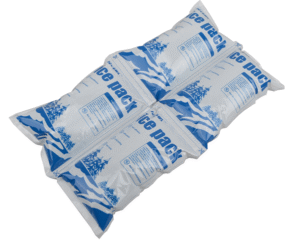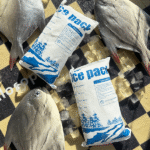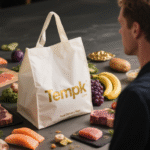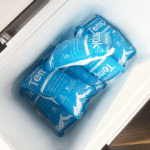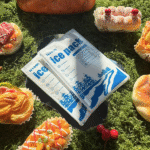Almofadas de gelo seco: Como escolher, Tamanho & Envio 2025
Se você enviar perecíveis, dry ice pads can keep food safe or frozen when used correctly—and compliant labeling matters when real dry ice (CO₂ sólido) está envolvido. Comece com regras simples: plano 5–10 lb de gelo seco por 24 horas for deep-frozen lanes and keep chilled foods ≤40°F (4°C) ponta a ponta. Para viagens de passageiros, O gelo seco é limitado a 2.5 kg por pacote. Atualizado: Agosto 18, 2025.
-
Escolha o certo dry ice pads type for chilled vs. pistas congeladas (longa cauda: almofadas de gelo seco para transportar comida).
-
Calcular how many dry ice pads or pounds of dry ice you need for 24–72 hours (longa cauda: Quantas almofadas de gelo seco eu preciso).
-
Pack and label UN1845 dry ice correctly in 2025 para evitar rejeições (longa cauda: Regras de envio de gelo seco 2025).
-
Usar PCM pads and gel packs to skip hazmat when deep-freeze isn’t required.
What are dry ice pads—and which type do you need?
Resposta curta: Dry ice pads can mean two things. Insulated dry ice pads are fabric covers used with real dry ice para retardar a sublimação. Reusable “dry-ice‑style pads” are polymer/PCM sheets you hydrate or freeze; eles são não CO₂ and suit chilled or moderate frozen ranges. Use real dry ice for ultracold (-78,5 ° C.) and use pads/PCM for 2–8°C or −10°C to −20°C targets.
Por que isso importa: Real dry ice requires vented packaging and UN1845 Marcas; reusable pads/PCM don’t release gas and avoid hazmat paperwork, making handoffs simpler for many food lanes.
When should you choose PCM “dry ice pads” vs. Gelo seco real?
Para −20°C frozen but not ultracold: escolha PCM pads (por exemplo, 5°F/−15°C setpoints) to stabilize loads without CO₂ handling. Para ultracold or hard-frozen (sorvete, long-haul meats), escolher Gelo seco real and vent the shipper. De qualquer jeito, pre-chill products and fill voids to slow heat gain.
| Pad / Tipo de refrigerante | O que é isso | Faixa de temperatura típica | O que isso significa para você |
|---|---|---|---|
| Insulated dry ice pad (cover) | Fabric/insulated topper used com gelo seco | Works with −78.5°C | Reduces sublimation during frequent access; not a coolant by itself. |
| Hydrated “dry-ice‑style” pad sheet | Polymer cells you wet/freeze | ~10–32°F (−12–0°C) | Great for 2–8°C chilled; fácil, non‑hazmat; ajuste flexível. |
| PCM panel (~5°F/−15°C) | Fixed‑setpoint phase‑change pack | ~5–20°F (−15–−6°C) | Bridges chilled–frozen gap; more stable than gel; no CO₂ gas. |
| Gelo seco (Co₂, UN1845) | Dióxido de carbono sólido | -78,5 ° C. (−109,3 ° F.) | Best for ultracold; requer ventilação + rotulagem; plan mass carefully. |
Dicas práticas para você
-
Acesso frequente? Add an insulated dry ice pad over dry ice between picks to slow loss.
-
Pistas refrigeradas (≤40°F): Usar dry ice pads (sheets/gel) and pack tight; add a 5°F PCM if ambient is hot.
-
Congelado (−20°C) without hazmat: Usar PCM pads around the payload for a flat cold plateau.
Caso real: A cheesecake brand compared six “dry‑ice‑style” pads + two PCM panels vs. 12 lb dry ice in a 30‑qt shipper over 30 horas. Pads/PCM held 34–38°F with zero leaks; dry ice kept rock‑solid frozen—ideal for hard‑frozen SKUs.
How many dry ice pads—or pounds of dry ice—do you need?
Planning rules you can trust: Para refrigerado pistas, comece com ≈1 lb of pad/gel per cubic foot per 24 h; scale up 25–50% for hot routes or thin insulation. Para Frozen profundo, plano 5–10 lb de gelo seco por 24 h per well‑insulated box. Validate with a small test and a logger before you scale.
Estimador rápido (copiar/colar):
| Tamanho do contêiner | Dry ice pads para 24 h (refrigerado) | Gelo seco para 24 h (congelado) | O que isso significa para você |
|---|---|---|---|
| 25-qt remetente | 2–3 hydrated pad sheets + 1 PCM panel | ~10–15 lb | Pads hit 33–40°F; use dry ice for hard‑frozen outcomes. |
| 45-qt remetente | 4–5 pad sheets + 2 Painéis PCM | ~15–20 lb | Layer top & bottom for uniform temps. |
| 60-qt remetente | 6 pad sheets + 2–3 PCM panels | ~18–25 lb | Fill voids and pre‑chill cargo to slow heat gain. |
Field‑tested sizing cues
-
Hot route or long transit? Adicionar 25–50% coolant and consider PCM to smooth swings.
-
Referência: A 25‑qt cooler typically needs ~10–15 lb/day of dry ice for frozen results.
How to pack with dry ice pads (and with dry ice) for safe delivery?
Chilled with pads/PCM/gel (sem materiais perigosos):
Pré -Chill product ≤40°F; line bottom with pads; flank with PCM on the sides; top with gel; preencher vazios; completamente selo (no vent needed for pads/gel).
Frozen with dry ice (pátria):
Freeze solid, lugar gelo seco por cima (pias frias), vent package, e marca: "Gelo seco" ou "dióxido de carbono, sólido,” UN1845, Peso da rede de gelo seco (kg), mais Aula 9 rótulo. Siga o 2025 Lista de verificação de aceitação.
Rotulagem & 2025 compliance made simple (UN1845)
-
Ventilação: Never airtight—allow CO₂ to escape to avoid rupture.
-
Marks: Nome de envio adequado, UN1845, NET KG, remetente/consignatário, Aula 9 diamante.
-
Viagens aéreas: 2.5 kg dry ice per passenger package, aprovação da companhia aérea necessária.
-
Postal/Express: USPS air ≤5 lb; FedEx/UPS mirror IATA/49 CFR for packaging & Marcas.
Texto da etiqueta de cópia (exemplo):
Pro tips that prevent warm arrivals
-
Condição prévia: Freeze PCM/gel 24–36 h; pre‑chill boxes.
-
Colocação: Gelo seco no topo; almofadas fundo + principal; Minimize o espaço da cabeça.
-
Validação: Drop a mini temperature logger in pilot boxes; standardize SOPs by lane.
Case in one line: With six pad sheets + two PCM panels, a 30‑hour lane held 34–38°F and avoided DG fees, while the same box with 12 lb de gelo seco arrived frozen solid. Choose per SKU and promise.
2025 trends in dry ice pads & cold chain—what changed?
Instantâneo: O 2025 Aqui está DGR (66th ed.) and carrier checklists formalize UN1845 weight/marking clarity; Adoção de PCM grows as brands seek non‑DG stability for −20°C runs; Forros VIP and better insulation reduce required coolant mass. Expect hybrid packs: PCM dry ice pads around the payload, com um smaller dry‑ice topper for margin.
Último progresso em um olhar
-
Clareza da lista de verificação: Fewer acceptance rejections when UN1845 and net kg are on the same panel.
-
−20°C PCM maturity: More vendors, better hold times, simpler reconditioning.
-
CO₂ supply dynamics: Mixed strategies hedge price/availability risk with PCM hybrids.
Insight de mercado: As insulation improves (por exemplo, Forros VIP), you’ll often ship the same payload with fewer pads or less dry ice, trimming freight and DG fees without sacrificing temperature.
Perguntas frequentes
1) Are dry ice pads the same as dry ice?
Não. Insulated pads cover real dry ice to slow loss; reusable “dry‑ice‑style” pads are gel/pcm and suit chilled/moderate frozen—não ultracold −78.5°C.
2) Quanto gelo seco por dia devo planejar?
Comece com 5–10 lb por 24 h in a quality shipper; add 20–30% for summer lanes; verify with a test.
3) Do PCM “dry ice pads” need hazmat labels?
Não. PCM pads don’t release CO₂ gas and don’t require Class 9 labels—still validate duration.
4) Posso voar com gelo seco?
Sim - até 2.5 kg per passenger package in a ventilado container with airline approval and proper marks.
5) What food safety target should I follow for chilled shipments?
Keep foods ≤40°F (4°C) from packout through delivery; log pilot runs to confirm.
Resumo & PRÓXIMOS PASSOS
Pontos -chave: Usar dry ice pads (pads/gel/PCM) for chilled or −20°C lanes; escolher gelo seco for ultracold, e ventilação + etiqueta UN1845 corretamente. Plano 1 lb/ft³/24 h for pads/gel and 5–10 lb/24 h Para gelo seco, então valide com um logger. Mantenha a comida ≤40°F across the journey.
Plano de ação:
-
Set your temperature goal (refrigerado vs.. congelado).
-
Escolha o refrigerante: pads/PCM for chilled/−20°C; gelo seco para ultracold.
-
Use o estimador acima; add a summer buffer.
-
Imprimir etiquetas (se estiver usando gelo seco) e siga o 2025 Lista de verificação.
-
Run a lane pilot, review data, then codify your SOP.
60‑Second Coolant Picker (lista de verificação interativa)
-
Eu preciso de ultracold (≤−70°C) → Gelo seco + insulated pad cover; Etiqueta UN1845; ventilado.
-
Eu preciso de congelado (−20°C) → PCM “dry ice pads” around payload; avoid DG paperwork.
-
Eu preciso de refrigerado (2–8 ° C.) → Hydrated pad sheets/gel; full coverage; espaço livre mínimo.
Sobre Tempk
We design cold‑chain systems that meet your exact temperature and duration at the lowest total landed cost. Referência dos nossos engenheiros dry ice pads, gel, PCM, e isolamento against your lanes, em seguida, forneça POPs claros, safety notes, and label templates—validated with data loggers.
CTA: Want a free one‑lane packout template or sizing check? Fale com um especialista em tempk hoje.






